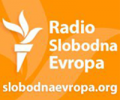Kosovo Artists Use Culture to Promote Justice and Peace
Artists and cultural activists from Kosovo have been using their work to address the traumas of the wartime past – but collaborations with Serbian artists intended to bridge post-war divides have sometimes sparked angry reactions.
‘Miredita, Dobar Dan’ – the festival’s name means ‘good day’ in Albanian and Serbian – is intended to showcase Kosovo culture to a Belgrade audience.
But it has been repeatedly targeted by demonstrations – such as when Rona Nishliu, a famous singer from Kosovo, held a concert during the first festival in 2014, and when former Kosovo President Atifete Jahjaga said she intended to make a speech at the event.
Before the 2018 festival, Serbian police confiscated three photographs by the Kosovo Albanian artist Eliza Hoxha, which were due to be exhibited at the festival, as she was crossing the border into Serbia.
The photographs included images of symbols of the Kosovo Liberation Army, which is considered a terrorist organisation by the Serbian government. Serbia’s Interior Minister Nebojsa Stefanovic stated that by confiscating the photographs, he had prevented “the promotion of a terrorist organisation in the name of culture”.
Despite such reactions, art and culture are increasingly being used as a tool for understanding and coping with the past in both Kosovo and Serbia, as an adjunct to other methods of promoting post-conflict justice and seeking reconciliation.
Artistic interventions can provide “informal counterparts for the most significant mechanisms of transitional justice: truth and reconciliation process, public lustration, public apology, psychological reparation, demand for public access to governmental records, and others”, suggested Sanja Bahun in her chapter on the subject in a 2015 book entitled ‘Theorising Transitional Justice’.
Orli Fridman, an associate professor at Singidunum University in Belgrade, where she heads the Centre for Comparative Conflict Studies, suggests that the ‘Miredita, Dobar Dan’ festival is an example of “people to people” initiatives that offer alternative approaches to the Kosovo-Serbia conflict from those offered by politicians on both sides.
“Additionally, I argue that such a festival is also offering an alternative to growing top-down and everyday nationalism,” Friedman writes in a forthcoming article for an academic journal called Nations and Nationalism.
However, opposition to efforts to promote reconciliation between Serbs and Kosovo Albanians remains significant. In March this year, when the documentary film ‘Ferdonija’, about the life of a Kosovo woman who lost her family in the war, was shown in Belgrade, several hundred football hooligans tried to enter the screening and smash it up.
‘Reaching out to youngsters’
The Documentation Centre Kosovo, a venue that showcases transitional justice issues in Pristina, which was established by the Humanitarian Law Centre NGO, has held exhibitions and art installations since it opened in 2017.
Wade Goddard, who covered the conflicts in the former Yugoslavia as a freelance photographer for Reuters, the New York Times and Newsweek, has a permanent exhibition at the venue of his images that capture the suffering of the Kosovo war.
Another permanent exhibition consists of nine short documentaries showing how crimes committed in Kosovo have been investigated and prosecuted at the International Criminal Tribunal for the Former Yugoslavia.
A further exhibition organised this year by the Humanitarian Law Centre, entitled ‘Once Upon a Time and Never Again’, evoked memories of the children killed in Kosovo between 1998 and 2000 with a display of personal items like notebooks, report cards, clothes, shoes, school bags, toys, photographs and short stories.
“Twenty years after the end of the war in Kosovo, memorialisation through different forms of art is a proper way of reaching out to youngsters who have no sources of information regarding the war,” said Dea Dedi from the Documentation Centre Kosovo, who was part of the exhibition team.
“The objective of the exhibition is to remember the interrupted childhoods as a result of the war in Kosovo. Through the stories behind them and the things belonging to them, this exhibition serves as a call to raise awareness in society, as well as to build a collective memory,” Dedi added.
One of the most impressive uses of art to deal address some of the most sensitive aspects of the 1990s conflict was a project by Kosovo artist Alketa Xhafa Mripa.
With her exhibition ‘Thinking of You’ in 2015, Alketa used the main football stadium in Pristina as her canvas, which she decorated with thousands of dresses and skirts donated by people all over Kosovo, turning it into a powerful tribute to survivors of sexual violence, aiming to pierce the silence surrounding wartime rape.
Kosovo’s then president, Atifete Jahjaga, was the first person to donate a dress, praising the solidarity and support that the artwork generated for the victims. Jahjaga said that it was the perpetrators who should be shamed, not the women who they assaulted.
‘We have a moral obligation’
After the war ended, Andrej Nosov, who was almost 20 at the time, crossed the Merdare border point into Kosovo. There was no bus, so he had to walk.
It was a strange time for a Serb to wander around in Kosovo, speaking Serbian, he recalled.
Nosov, who grew up in Kosovo before the war and is now a political activist and artist, said that the situation has changed since his first post-war visit to Kosovo, but not the rhetoric about the way Serbs and Kosovo Albanians see each other. But art and culture can and should play a role in changing things, he insisted.
“The artistic community has to do much more in the future, because it is never enough. For these relations and understanding of those complex and very tragic relationship between the two nations, we need more to be done,” said Nosov, who also founded the well-known Youth Initiative for Human Rights NGO.
Progress has been made, however, he added: “Of course there are bright and talented artists trying to understand the other side, we have specific examples of important exhibitions, theatre plays and books that have opened up a space for breaching the gap between communities.”
Nosov produces his own plays and directs dramatic works, addressing issues like the politics of memory, post-conflict justice and reconciliation, and the rights of marginalised communities.
“Artists are citizens, and we as citizens have the moral obligation to look around ourselves and see who is racist and who is not, and to fix things,” he said.
“An important question is the one about accountability and responsibility, which is addressed to all of us,” he added.
Nosov is currently working on developing a theatre piece about Kosovo in which he is trying to use Serbian Orthodox narratives from history.
“Were there any positive parts of the history between Kosovo and Serbia, was there any period when these people could live together; is it possible that all our history is described in one certain way?” he asked.
“Kosovo is very important to me because somehow I grew up there, and Kosovo is an important topic in what I do. On the emotional level, I want to tackle the fact that there was a war, the fact we lost something, the broken relationships and missing people,” he added.
Nosov is the managing director of Heartefact, an NGO involved in staging politically-conscious theatre plays, which organised the Belgrade production of ‘Gishti’ (‘The Finger’) by Doruntina Basha, a playwright and screenwriter from Pristina.
‘The Finger’ tackles the topic of missing persons from the Kosovo war in an original way – from the perspective of the women that left behind after their husbands disappeared.
“In many traditional Kosovar houses, it still happens that women of men who disappeared during the war are continuing to live with their husband’s family, even though it’s been more than a decade since the war. The right over their lives, which once belonged to their husbands, now belongs to his family. They do not have a ‘private’ life,” Basha said in a synopsis of the play.
“I wanted to give a voice to a community passing life in silence: the families of missing people in the war in Kosovo. They are such a large number and their stories are almost unknown to us. The fact that their voice is missing tells a lot about how much we have failed in processing, understanding and also overcoming our traumatic past,” she said.
Basha has produced the play in Belgrade, Skopje, Sarajevo, Vienna, Pristina and Tirana, and said she believed that art and culture can play a unique role in addressing painful events from the past.
“It would be great if each artist living in a post-war context used personal ‘weapons’ to help society understand, process and overcome the traumatic experience of war. Art has this unique advantage: it’s open and accessible to all, doesn’t exclude anyone and isn’t prejudiced,” she explained.
“Therefore it is one of the safest platforms in which dealing with the past could happen, a dialogue that no other platform allows,” she added.
However, artists have to be careful when dealing with such issues, she cautioned: “Working with dealing with the past through art is very sensitive: there is always a risk that a work of art will re-traumatise the audience.”
‘Collaborations do not offer an amnesty’
Kosovo writer Shkelzen Maliqi has been involved in Kosovo-Serbia artistic co-operation initiatives for decades. Back in 1997, he took part in an exhibition entitled ‘PERTEJ’, which brought Kosovo artists to show their work in Belgrade at the Centre for Cultural Decontamination, an alternative arts and ideas venue which was part of the opposition to Slobodan Milosevic’s regime.
At the time of the exhibition, although the Kosovo war had not broken out yet, repression of ethnic Albanians under Belgrade’s rule was widespread.
“At that point, a lot of people [in Kosovo] were saying to us, what are you looking for in Belgrade? This only legitimises the current state in Kosovo! Why do you need to acknowledge the supremacy of Belgrade, no matter the fact that the Centre for Cultural Decontamination is against the Milosevic regime?” Maliqi recalled.
“I continued to defend the fact that ‘PERTEJ’ was an initiative to break down borders and create communication between artists,” he added.
In June 2018, Maliqi was effectively prevented from participating in ‘PERTEJ/BEYOND/PREKO 20 YEARS’, an event in Belgrade to promote a book looking back on that exhibition, after he was held up at the border by Serbian police officers. The event was then cancelled by the organisers in protest against unwarranted restrictions on the freedom of movement for Kosovan artists.
Despite this, Maliqi said that he continues to believe that artistic collaborations between Kosovo Albanians and Serbs are important, as they are destined to remain neighbours.
“The actual [current] Serbian regime is a continuation of the one during the nineties, but the connection we have today with Serbian culture is not for their sake, but for the sake of peace-loving and rational people in Serbia. There are few of them today, but we cannot ignore them – let us not forget that these are people who are asking the state to officially apologise for all crimes,” he explained.
“Collaborations do not offer an amnesty for the crimes, but create a space for a future in which neighbours respect each other and develop normal cultural exchanges,” he concluded.
This article was produced as part of BIRN’s Balkan Transitional Justice grant scheme, supported by the European Commission.








